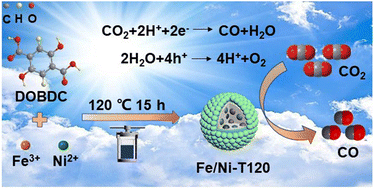Optimization of Fe/Ni organic frameworks with core–shell structures for efficient visible-light-driven reduction of carbon dioxide to carbon monoxide†
Abstract
To address CO2 emissions caused by the overuse of fossil fuels, photocatalytic CO2 reduction from metal–organic frameworks (MOFs) to valuable chemicals is critical for energy conversion and storage. Core–shell MOFs improve interfacial interactions, increasing the number of active sites in the catalyst, thereby improving the photocatalytic reduction. In this work, the catalytic performance of Fe/Ni-MOFs toward photocatalytic CO2 reduction was improved using a bimetallic strategy. We successfully synthesized a series of Fe/Ni-MOFs with a core–shell structure using a single-step approach combined with hydrothermal synthesis. By altering the synthesis conditions of the bimetallic organic skeleton and contrasting it with a single MOF, we successfully synthesized Fe/Ni-T120 through an efficient photocatalytic reduction of CO2. The results of photocatalytic CO2 reduction experiments indicated that upon using [Ru(bpy)3]Cl2·6H2O as a photosensitizer and triethanolamine (TEOA) and acetonitrile (MeCN) as sacrificial agents, the CO evolution rate of Fe/Ni-T120 reached 9.74 mmol g−1 h−1 and the CO2 to CO selectivity reached up to 92.1%. Additionally, Fe/Ni-T120 has a broad response range to visible light, a high photocurrent intensity, good chemical stability, and strong photocatalytic efficiency, even after repeated cycles. This study proposes a straightforward method for producing adaptable and stable MOFs for effective photocatalytic CO2 reduction that is driven by visible light.



 Please wait while we load your content...
Please wait while we load your content...